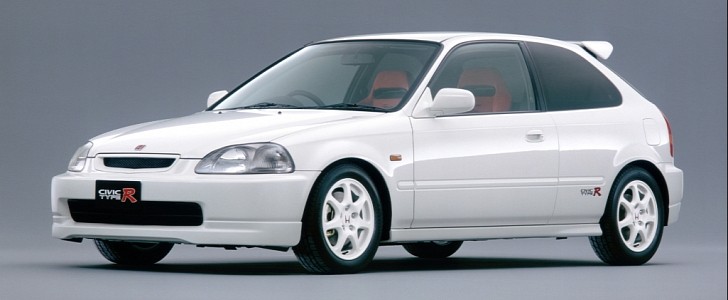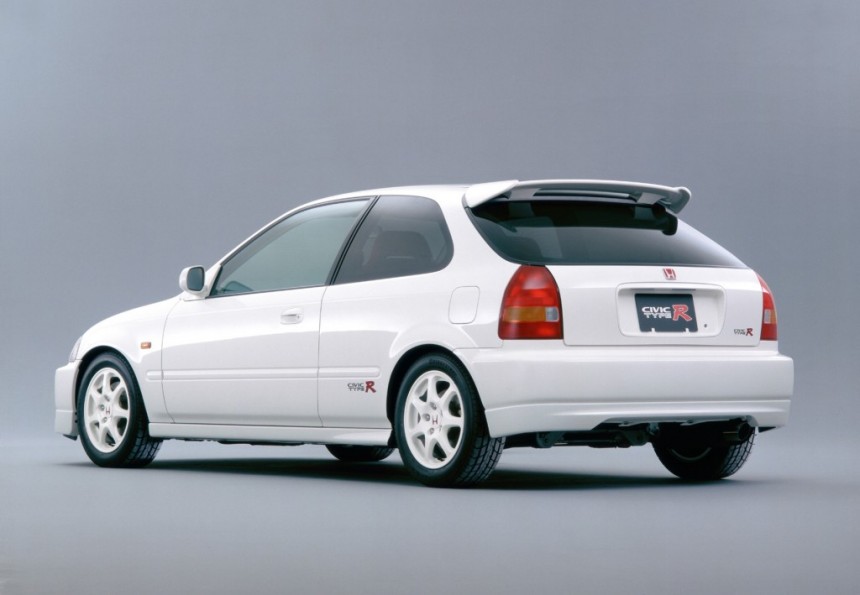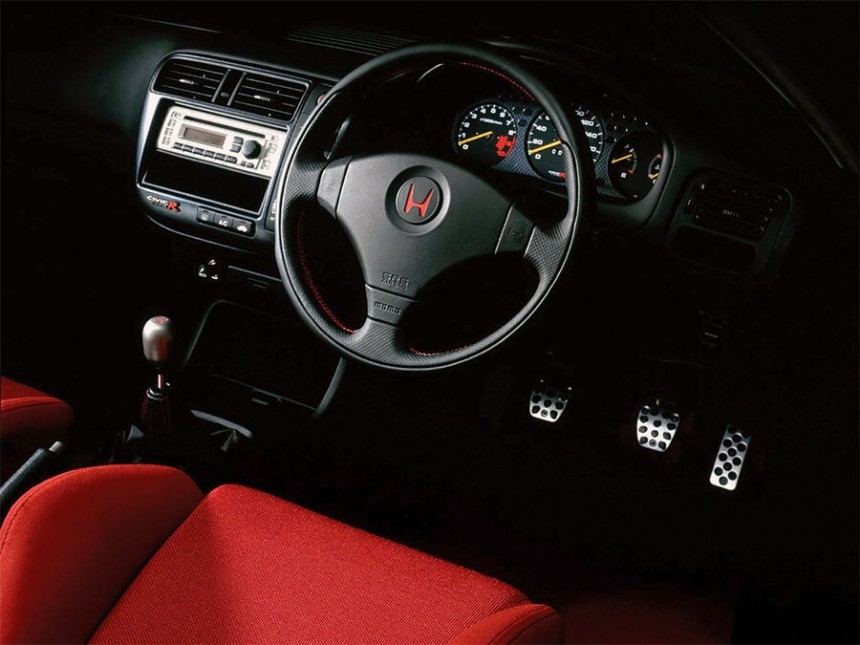Introduced in 1972 as a subcompact, the Civic was the first Honda to sell in great volumes outside of Honda’s home market. Baptized 1200 RS, the first sporty was introduced in 1974. The first Type R had to wait until 1997, the year Daft Punk released their debut album to great acclaim.
Based on the EK4 SiR three-door hatchback produced exclusively for Japan, the EK9 Type R was launched in August 1997 for the 1998 model year as a three-door hatchback for the Japanese market. The third Type R after the NSX and Integra, this fellow is rocking front-wheel drive and a five-speed manual gearbox connected to a helical limited-slip differential.
Manufactured in Suzuka, close to the Honda-owned racing circuit where the all-new Civic Type R broke the FWD lap record in March 2022, the first Civic to bear the Type R suffix rides on a 2,620-mm (103.1-in) wheelbase. Developed specifically to be rigid, the car’s seam-welded monocoque is complemented by double wishbones on every corner and 16-inch wheels.
The five-inch-wide alloys came in Championship White, mounted with Bridgestone Potenza rubber boots. Behind those magnificent seven-spoke wheels, Honda originally fitted 282- and 260-millimeter brake rotors. Stiff dampers and thick anti-roll bars are featured as well, along with strut braces that improve the handling and reduce the body roll during hard cornering.
Fitted with a 45-liter (11.9-gallon) fuel tank under the trunk floor, the sixth-gen Civic-based Type R features identical tracks fore and aft. Under the hood, the EK9 hides a 1,595-cc engine from the Honda B series. The B16B uses the same cast-iron block as the Integra Type R. Gifted with a lightweight alloy head, an 81-mm bore, 77.4-mm stroke, and a compression ratio of 10.8:1, the free-breathing lump engages VTEC at 6,100 revolutions per minute. The tachometer indicates a redline of 8,400 rpm. Go any higher than that, and you will need upgraded valve springs to address valve float.
The B16 was introduced through the Integra XSi and CRX SiR, and over the years, Honda developed countless versions of this engine. The blueprinted powerplant in the Civic Type R benefits from lightweight connecting rods, low-friction pistons, high-lift camshafts, a ported and polished head, platinum spark plugs, a fully-balanced crankshaft, and Honda's PGM-FI programmed fuel injection. The PGM-FI system uses two basic variables, the engine speed and throttle angle, to tailor the air/fuel mixture.
Capable of 185 ps (182 horsepower) at 8,200 revolutions per minute and 160 Nm (118 pound-feet) at 7,500 revolutions per minute, the B16B was a serious piece of kit for that era. Tipping the scales at 1,040 kilograms (2,293 pounds) to 1,090 kilograms (2,403 pounds) depending on the spec, the EK0 could reach 225 kilometers per hour (140 miles per hour). Zero to 100 kilometers per hour (62 miles per hour) is dealt with in under seven clicks.
Three colors were offered in total: Championship White, Starlight Black Pearl (a.k.a. Flamenco Black Metallic), and Vogue Silver Metallic. Red fabric was used for the Recaro buckets up front while gray fabric was employed for the rear seats. A titanium shift knob, MOMO steering wheel, carbon-like fascia for the instrument cluster, and two airbags are featured.
Power windows and mirrors are standard as well, but power-folding mirrors were offered for a few additional yen over the starting price of 1,698,000 yen. Adjusted for inflation, make that 1,752,270 yen. Converted to freedom eagles, you’re looking at $14,125 for a great-handling Japanese hot hatch.
Those numbers are borderline ridiculous when compared to the $38k starting price of the FK8 Civic Type R. Considering that dealerships have this bad habit of slapping market adjustments on these cars, it’s no wonder the current pool of customers is a bit older than expected from a hot hatch.
Honda improved the EK9 in 1998 for the 1999 model year with brake cooling ducts in the front bumper and a larger front intake grille. From an aesthetic standpoint, the Japanese automaker had also modified the front fenders and headlights. The amber taillights were swapped for clear units.
As opposed to the original EK9-100, the EK9-110 also benefitted from a few interior updates and a fourth exterior color in the guise of Sunlight Yellow. Introduced into production in1999 for the 2000 model year, the EK-120 was marketed under the Type Rx handle. The final incarnation of this modern classic, the Type Rx came with remote central locking, a CD-playing stereo, automatic air conditioning, and drilled aluminum pedals.
Including the track-focused Motor Sports Edition, which came with steelies and no power anything, the EK9 Civic Type R totaled 16,241 units split between 7,007 pre-facelifts, 4,009 facelifts, and 5,225 final-year cars.
Manufactured in Suzuka, close to the Honda-owned racing circuit where the all-new Civic Type R broke the FWD lap record in March 2022, the first Civic to bear the Type R suffix rides on a 2,620-mm (103.1-in) wheelbase. Developed specifically to be rigid, the car’s seam-welded monocoque is complemented by double wishbones on every corner and 16-inch wheels.
The five-inch-wide alloys came in Championship White, mounted with Bridgestone Potenza rubber boots. Behind those magnificent seven-spoke wheels, Honda originally fitted 282- and 260-millimeter brake rotors. Stiff dampers and thick anti-roll bars are featured as well, along with strut braces that improve the handling and reduce the body roll during hard cornering.
Fitted with a 45-liter (11.9-gallon) fuel tank under the trunk floor, the sixth-gen Civic-based Type R features identical tracks fore and aft. Under the hood, the EK9 hides a 1,595-cc engine from the Honda B series. The B16B uses the same cast-iron block as the Integra Type R. Gifted with a lightweight alloy head, an 81-mm bore, 77.4-mm stroke, and a compression ratio of 10.8:1, the free-breathing lump engages VTEC at 6,100 revolutions per minute. The tachometer indicates a redline of 8,400 rpm. Go any higher than that, and you will need upgraded valve springs to address valve float.
Capable of 185 ps (182 horsepower) at 8,200 revolutions per minute and 160 Nm (118 pound-feet) at 7,500 revolutions per minute, the B16B was a serious piece of kit for that era. Tipping the scales at 1,040 kilograms (2,293 pounds) to 1,090 kilograms (2,403 pounds) depending on the spec, the EK0 could reach 225 kilometers per hour (140 miles per hour). Zero to 100 kilometers per hour (62 miles per hour) is dealt with in under seven clicks.
Three colors were offered in total: Championship White, Starlight Black Pearl (a.k.a. Flamenco Black Metallic), and Vogue Silver Metallic. Red fabric was used for the Recaro buckets up front while gray fabric was employed for the rear seats. A titanium shift knob, MOMO steering wheel, carbon-like fascia for the instrument cluster, and two airbags are featured.
Power windows and mirrors are standard as well, but power-folding mirrors were offered for a few additional yen over the starting price of 1,698,000 yen. Adjusted for inflation, make that 1,752,270 yen. Converted to freedom eagles, you’re looking at $14,125 for a great-handling Japanese hot hatch.
Honda improved the EK9 in 1998 for the 1999 model year with brake cooling ducts in the front bumper and a larger front intake grille. From an aesthetic standpoint, the Japanese automaker had also modified the front fenders and headlights. The amber taillights were swapped for clear units.
As opposed to the original EK9-100, the EK9-110 also benefitted from a few interior updates and a fourth exterior color in the guise of Sunlight Yellow. Introduced into production in1999 for the 2000 model year, the EK-120 was marketed under the Type Rx handle. The final incarnation of this modern classic, the Type Rx came with remote central locking, a CD-playing stereo, automatic air conditioning, and drilled aluminum pedals.
Including the track-focused Motor Sports Edition, which came with steelies and no power anything, the EK9 Civic Type R totaled 16,241 units split between 7,007 pre-facelifts, 4,009 facelifts, and 5,225 final-year cars.










